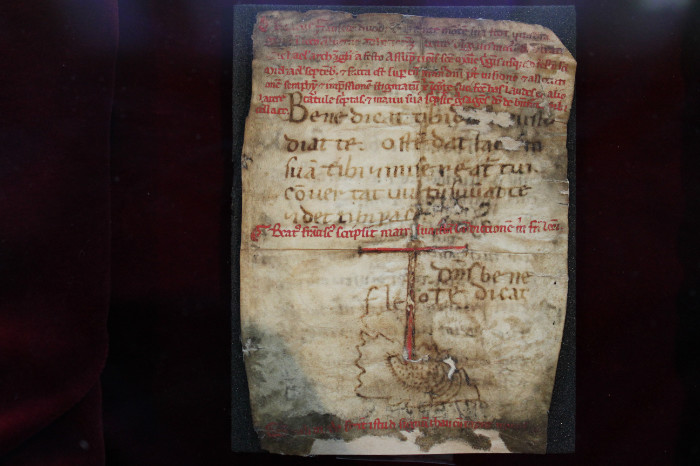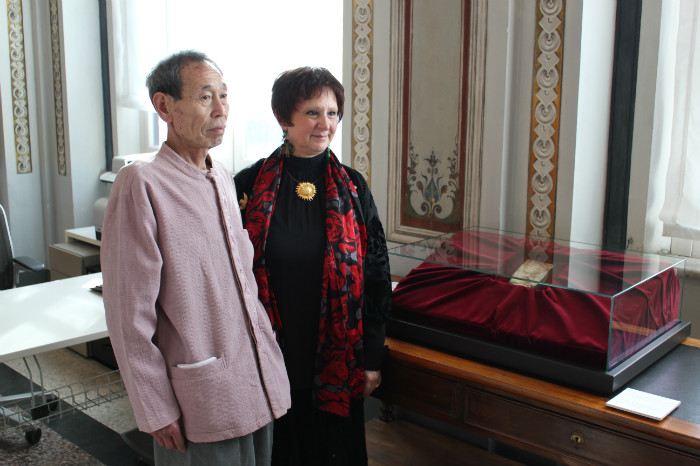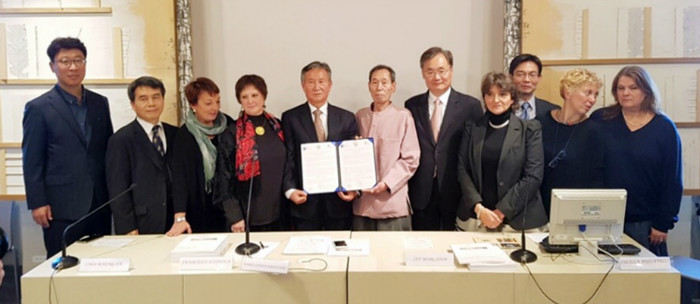The Chartula is a handwritten prayer on parchment by St. Francis of Assisi (1182~1226), a Roman Catholic saint and one of the patron saints of Italy, in 1224. Hanji was used to strengthen the damaged section at the bottom of the parchment.

The Chartula, handwritten prayers on parchment by St. Francisco of Assisi in 1224, was restored using hanji. The exhibition was open to the public on Dec. 12 at the Central Institute for Restoration and Conservation of Library and Archival of Cultural Heritage (ICRCPAL) in Rome, Italy.
Hanji, traditional Korean mulberry paper (한지, 韓紙), used to restore five Italian items of cultural heritage including the Chartula, was certified as a suitable material by the Central Institute for Restoration and Conservation of Library and Archival of Cultural Heritage (ICRCPAL), an official Italian institute for the conservation of paper artifacts. The institute is the European authority for the restoration of artifacts.
The four other artifacts are: the Rossano Gospels; a collection of the coat of arms of Sardinia; Music Volume 243 in Casanata Library in Rome, Italy and a painting of Pietro da Cartona, a Baroque artist.
ICRCPAL runs various testing including chemical testing, acidity testing, biological testing, physical-chemical testing and technological testing before approving appropriate materials for the restoration process. Two types of mulberry paper made at the workshop of craftsman Shin Hyun-se in Uiryeong, Gyeongsangnam-do Province passed the tests: “Uiryeong Shinhyunse Traditional Hanji 1” and “Uiryeong Shinhyunse Traditional Hanji 2.” It is a first for hanji to be certified by a foreign official institute for such use.

Craftsman Shin Hyun-se (left) and Maria Letizia Sebastiani, the director of ICRCPAL, stand in front of the restored Chartula at ICRCPAL on Dec.15.
The use of Hanji in restoration and conservation of artifacts is set to broaden, as an official institute of Italy, a country with the biggest number of items of cultural heritage, has certified and used hanji in its restoration work. Its use is expected to spread further as the ICRCPAL shares this information with other related organizations around the world.

The certification ceremony was held at ICRCPAL in Rome, Italy on Dec.15. Choi Maeng-Sik, the director-general of the National Research Institute of Cultural Heritage of Cultural Heritage Administration (second from left), Maria Letizia Sebastiani, the director of ICRCPAL (fourth from left) and craftsman Shin Hyun-se (six from left) pose with the certificate.
“We will continuously promote the excellence of hanji for restoration of cultural heritage items in Europe and try to win more certifications on other types of hanji,” said an official from the Cultural Heritage Administration. “We plan to expand the use of hanji to fields other than restoration such as art,” he added.
By Kim Young Shin
Korea.net Staff Writer
Photos: the Cultural Heritage Administration, Uiryeong-gun County
ysk1111@korea.kr